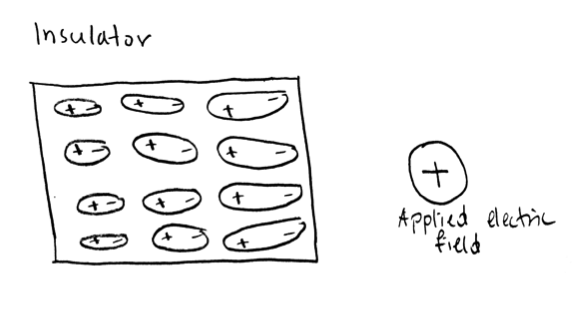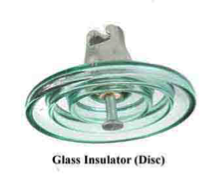Insulators: Difference between revisions
Zbartolek3 (talk | contribs) |
Zbartolek3 (talk | contribs) |
||
| Line 71: | Line 71: | ||
•Glass – used for high voltage | •Glass – used for high voltage | ||
[[File:glass.png]] | |||
•Neoprene | •Neoprene | ||
Revision as of 22:40, 27 November 2016
Edited by Raghav Srivastava and Dylan Chiodo on 4/17/16 , Edited by Zinka Bartolek Fall 2016
Insulators are materials that prevent the flow of electrical charges due to their high resistivities. While conductors have mobile charged particles that move that can move throughout the material, insulators do not contain mobile charged particles.

The Main Idea
An insulator is a material that does not allow electric charges to move freely through it. In insulators, electrons are tightly bound to the atoms, and there are not charged particles that can move through the material.
The property that defines whether a material is an insulator is its resistivity. Insulators have a very high resistivity, and they typically have high numbers of mobile electrons as opposed to conductors which have very high amounts of mobile electrons. In fact, the amount of mobile electrons in insulators and conductors are usually many orders of magnitude apart.
Like many things in the real world – there is no such thing as a perfect insulator. A small number of charges will still be able to move, especially when a very high voltage is applied. Insulators are used in electrical equipment to separate conductors and as supports to keep current from flowing where it shouldn’t. In addition, air can be considered an insulator because, in practice, as long as two current carrying wires do not come in contact with one another, electrical current will not pass between them.
A Mathematical Model
Resistivity
Resistivity is the intrinsic property that quantifies how strongly a material opposes the flow of electric current. The units of resistivity are Ohms Meter, and the equation to solve for resistivity is:
[math]\displaystyle{ \rho = R \frac{A}{\ell}, \,\! }[/math] where R is resistance, [math]\displaystyle{ \ell }[/math] is the length of the material and A is the cross sectional area of the specimen.
To calculate resistivity, the size of the material is taken into account along with the resistance. Many objects can claim to have roughly the same resistance, but by taking into the specific dimensions of the material into account we find the resistivity, which is specific to each material. From the equation, it can be concluded that resistivity is an intrinsic property of a material, allowing it to be similar across all specimens of a material. For example, ceramic will have a much high electrical resistivity than copper, however, the resistivity of two ceramic specimens with same dimensions will be the same.
Band Theory
Electrons tend to seek the lowest energy state in their configuration, and the characteristic state, or band, at which the electrons of an element have filled up to is called the Fermi level. Only electrons near the Fermi level are allowed to "jump" to another atom, which is how the electron sea of metals works. Metals have many electrons near their Fermi levels, allowing them to have great conductivity as compared to other materials. The opposite is true for insulators. In an insulator the amount of electrons available for conduction is close to none, meaning a high voltage potential at one end of the insulator will cause little to no change in the electrical structure of the insulator.
Polarization of Insulators
In insulators, all charged particles are tightly bound to the molecules making up the material. When an electric field is applied, the charged particles (electrons) in an insulator shift position slightly but still stay bound to the molecules. The largest distance the charged particles can move is about one atomic diameter, which is 1xe-10 m. Because the mobile charge is displaced by such a small distance, the polarization happens very quickly. The whole process can generally take less than a nanosecond to complete.
The image bellow shows a solid block of insulating material whose molecules are polarized by an external electric field. The the example shown, the applied electric field is a single external positive charge. The electrons in each molecule are moved by a very short distance, however, the molecules themselves do not move. Polarized molecules align with the external electric field polarizing them. A stronger applied electric filed will cause a larger displacement of the electrons in the molecules. For example, the part of the insulator closer to external charge will have molecules that are more extended that the part of the insulator further away from the electric field.
Testing Resistivity
To test the resistivity of an insulator we need to look at the breakdown voltage. The breakdown voltage of an insulator is the minimum voltage required to make a portion of the insulator become conductive. This is done by creating a weakened path in the material – a permanent physical or molecular change to the material. Basically the voltage gives the electrons enough energy to be excited. Many will use this to test for the maximum amount of voltage a material can withstand prior to it completely collapsing.
Uses
Insulators are prominent when wires are going to be crossing and potentially touching. Because air is an insulator, wires that have no chance of crossing or touching another can potentially be left to be insulated by the air. When wires cross and touch, short circuiting is a very common problem and creates a fire hazard. With wires that are carrying very high voltages, electrocution becomes a concern. Because insulators do not allow current to flow, portions of the electrical wires can be wrapped in an insulator and touch other wires with no hazard. This is so important that there are government regulations on what kinds of insulated wire can be used in buildings.
The use of insulators also allows for the extension of the life of many wires as the material also shields wires (such as power lines) from natural elements that would wear and/or corrode the wires.
Examples
Power lines
Typically these high voltage wires are insulated by air. Insulator materials are only used when the wires are connecting to a pole or support. Insulators are also required where these lines enter buildings and electrical centers. Ceramics (including glass), are the material of choice in building insulators for power lines, and they typically have an outer coat of gloss to prevent the buildup of condensation.
Antennas
Broadcasting antennas are basically a giant high voltage structure, so they must be insulated from the ground and be protected against lightning. Usually cables are used to break up the voltage and to help prevent short circuiting. Ceramic insulators are commonly used. The insulator is under compression as opposed to the tension that is seen with powerlines.
Different materials that are classified as insulators
•Ceramic - ceramics are made up of ions, the electronic contribution to thermal conductivity is practically zero. The only way for heat transfer within the ceramic is through the atomic-scale vibrations in the crystalline lattice
•Acrylic
•Fiberglass
•Glass – used for high voltage
•Neoprene
•Nylon
•Polyester (Mylar)
•Porcelain – used for high voltage
•Silicone Rubber
•Teflon
Why is Teflon considered to be such a good insulator?
Teflon is a specially formulated compound known as PTFE that has many applications in industry and in the home. The material is used in many computers and aerospace application as well as in many kitchen items. Teflon is considered to be a nearly perfect insulator because of its ability to be more durable than other insulators in extreme environments. There is some controversy behind its use over whether or not it is safe for use in foodservice.
Types of insulators
•Pin type: These are mounted on a pin at the cross-arm on a pole. These are used for communication cables, and for wires caring voltages up to 33kV. Above this voltage these insulators are not useful. [1]
•Suspension: These are lots of glass discs connected in series with metal links. We use this insulator for voltages higher than 33kV. These are used in power lines. [2]
•Strain: This is the pole that is used when a line is ending or splitting off in a new direction. They are called strain insulators because they have to withstand the lateral load of the long sections of wire. [3]
Connectedness
- How is this topic connected to something that you are interested in?
I am really interested in circuits. Many of the other circuits topics were taken, but I do find it very interesting how a material can prevent charges from flowing.
- How is it connected to your major?
As a BME we work with many devices that require a current to run through them. If we do not use a good insulator, we run the risk of hurting a patient.
See also
References
Holtzhausen, J.P. "High Voltage Insulators" (PDF). IDC Technologies. Retrieved 2008-10-17.
Grigsby, Leonard L. (2001). The Electric Power Engineering Handbook. USA: CRC Press. ISBN 0-8493-8578-4
Bakshi, M (2007). Electrical Power Transmission and Distribution. Technical Publications. ISBN 978-81-8431-271-3.
http://www.allaboutcircuits.com/textbook/direct-current/chpt-12/insulator-breakdown-voltage/
http://www.engineeringtoolbox.com/resistivity-conductivity-d_418.html



